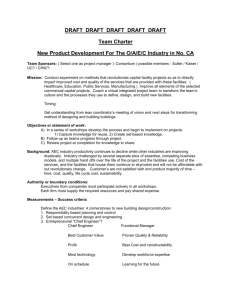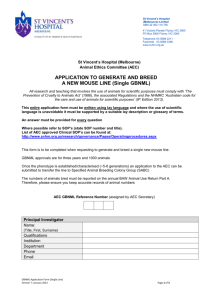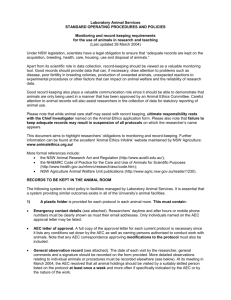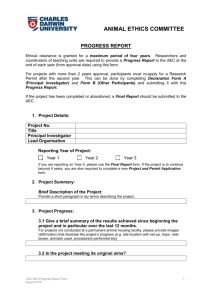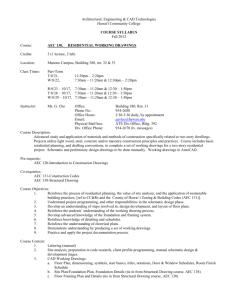Extranet Case Study - Graduate School of Computer and Information
advertisement
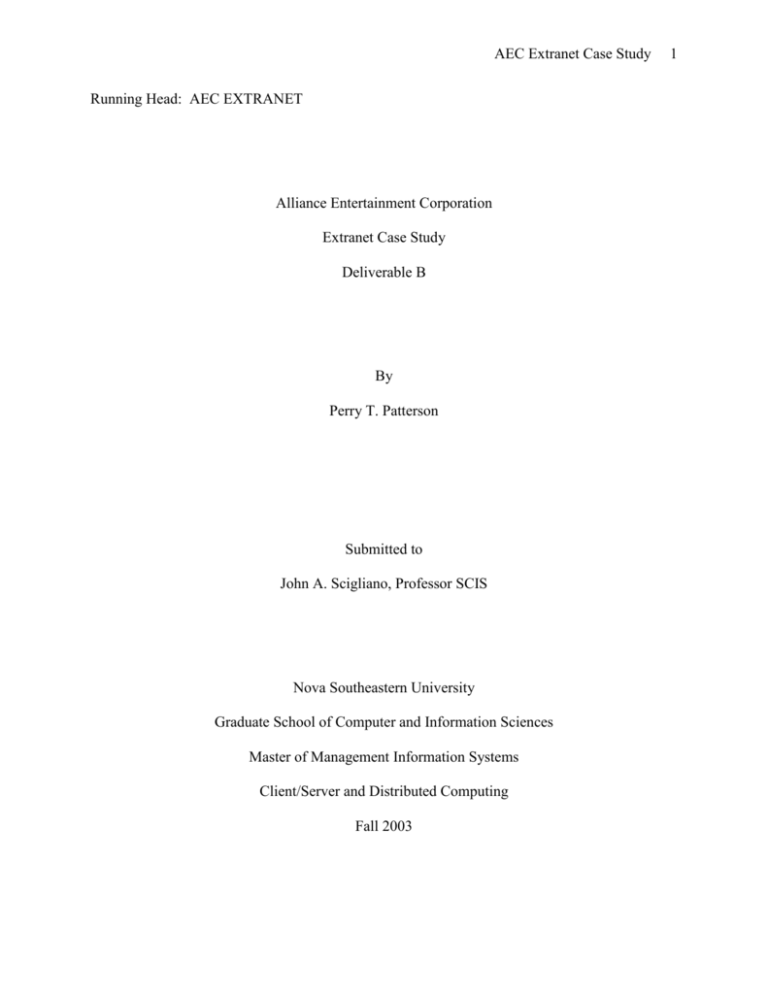
AEC Extranet Case Study Running Head: AEC EXTRANET Alliance Entertainment Corporation Extranet Case Study Deliverable B By Perry T. Patterson Submitted to John A. Scigliano, Professor SCIS Nova Southeastern University Graduate School of Computer and Information Sciences Master of Management Information Systems Client/Server and Distributed Computing Fall 2003 1 AEC Extranet Case Study Table of Contents …………………………………………...………………………… 3 Introduction …………………………………………...………………………… 4 ……………………………….………….……….… 4 ……………………………….….……….… 4 Background ……………………………………………………...……………… 5 Determining Needs ……………………………………………...……………… 6 AEC Extranet Reporting System ……………………………...……………… 7 ……………………………….………….……….… 7 ……………………….….……….… 8 Leveraging the AEC Data Warehouse ……………….….……….… 9 AEC as Application Service Provider ……………….….……….… 12 WebIntelligence ……………………….……….….….….……….… 13 Implementation ……………………….……….….….….……….… 15 ……………………………………………………...……………… 16 New Reports ……………………………….………….……….…...….… 16 ……………….………….……….… 17 ………………………………………………………………….….. 18 Appendix A: Figures ……………………………….………….……….…...….… 20 ……….………………….……….…...….… 21 ……….………….……….…...….… 23 Abstract Overview Statement of the Problem Extranet Overview Client-Server Implementation Expansion Upgrade and Implementation Plan Conclusion Appendix B: References / Cites Appendix C: References / Background 2 AEC Extranet Case Study 3 Abstract Alliance Entertainment Corporation (AEC), a large distributor of CDs and DVDs, created an extranet based, business intelligence reporting system. The system was used to give managers of internet retail stores valuable information they often could not obtain from their own organizations. AEC delivered data via EDI, but learned that the decision makers of their retailer partners rarely received this information in a viable format. AEC used WebIntelligence from Business Objects to save support time, assist their partners and enhance their strategic position in the industry. AEC Extranet Case Study 4 Introduction Overview: Case Study, Alliance Entertainment Corporation (www.aent.com), used to explore the roles of the “extranet” in helping organizations form partnerships with their customers, suppliers, and even competitors. Companies are constantly looking for ways to gain a “strategic advantage” and lock in client loyalty. Alliance Entertainment Corporation is doing this through the use of an extranet based reporting system using the product “WebIntelligence” from Business Objects (www.businessobjects.com). Statement of the Problem: Alliance Entertainment Corporation (AEC) provides fulfillment services for many internet based music and movie retailers. AEC produces traditional EDI files that are transmitted to clients on a regular basis. However, AEC’s account management and operation team found that the managers of the client sites seldom had access to the data produced. The client managers needed information to help manage and market their business and they were not getting assistance from their own Information Technology (IT) departments. According to Phil Russom (2002), business intelligence (BI) for the masses has been underway since 1996. Unfortunately, it still has not trickled down to the managers and marketing professionals running many Internet stores, especially in the tight budget economy. Christopher Koch (2001) in his Budget Playbook noted that IT spending is under greater scrutiny now than in recent years. AEC recognized the need of their clients to get timely information, and also that their client IT teams simply did not have the time and budget to get reports to the teams managing the day to day business. AEC Extranet Case Study 5 Background Alliance Entertainment Corporation (AEC) is one of the largest distributors of prerecorded entertainment media in the United States, located in Coral Springs, Florida. Prerecorded media is the market category for items such as CDs, VHS tapes and DVDs. AEC’s clientele includes chain stores, such as Barnes & Nobel and Wherehouse Muisc, Independent music stores and Internet based merchants selling music and video, such as Circuit City (www.circuitcity.com), Barnes & Nobel (www.bn.com) and Best Buy (www.bestbuy.com). AEC classifies their Internet based music and video retailers for account and operational support as Consumer Direct Fulfillment, or CDF. All transactions for AEC’s CDF are done via some form of Electronic Data Interchange (EDI). AEC receives orders and transmits back status and billing on virtually every detail imaginable regarding the outcome of orders processed. Many of the orders are completed and shipped direct to consumers on behalf of the retailers, hence the name Consumer Direct Fulfillment. However, the CDF team noted that clients were constantly asking for reports detailing the most popular products, methods of shipment and other information readily available in raw form. Competition in this industry is extremely tight. Elana Varon (2003) quoted Jeff Chasney, Executive Vice President and CIO with CKE Restaurants, who said “If you get the lowest cost and that hurts the vendor, you will suffer”. AEC as a vendor knew that they could not provide top levels of service if they only competed on price. However, AEC needed to find a way to leverage their internal expertise to trim support costs to the retailers. While one could argue that the Internet retailers should be able to create their own reports from the data already provided by AEC, AEC was reluctant to tell their clients “no”. It would be far too easy for one of AEC’s competitors to say “yes”. AEC Extranet Case Study 6 AEC previously invested in a Data Warehouse for gathering data from its various business units. The data was stored in an Oracle (www.oracle.com) database with a reporting system from Business Objects. The Business Objects reporting tool empowered the AEC personnel to rapidly generate the reports requested. Often, they found that the same reports were requested by many different clients, with small variations in time frame and data elements. The goal for AEC became very simple. What could AEC do to gain a strategic advantage over their competitors, help their retailer partners get the reports they needed for managing their business, leverage existing technology and save on support costs? Dan Stoller had the right idea when he said, as quoted by Sarah L. Roberts-Witt (2001), “We wanted to take our investment in data and turn that into a benefit.” The answer was in the Data Warehouse already in place and available on AEC’s intranet from Business Objects. Determining Needs AEC needed to determine what to give their clients, each which had different needs. They also needed to address the requirements in “Internet Time”, meaning fast or faster. Finally, AEC needed to ensure that data for the various clients was kept secure so that clients did not see each other’s information. AEC certainly could have done a formal study with each of its clients and documented what was required. However, as Michael Shrage (2003) noted “Most clients neither know what they want nor truly understand what they really need. They're ignorant. They don't quite ‘get’ IT, and their grasp of their own internal processes is uncertain.” What AEC realized is that they already had the requirements form their clients, in the form of previous requests. While clients may be ignorant when asked for a formal requirement, they could be pretty good when asking for AEC Extranet Case Study 7 something they just needed. AEC could simply gather the previous requests together for documentation and analysis. AEC already had a secure support site for the Internet clients where they could pick up documentation, see lists of industry top sellers and gather marketing materials (see figure 1). They needed their clients to feel comfortable with a new reporting system. As Michelle Champers (2001) said, “If you want your Internet channel to be successful, you need to create an experience that is understood and embraced by your users.” Building upon an existing internet support site was the ideal concept as it was already familiar to their clients. AEC’s existing Internet Retailer Support site already had a mechanism for client based logins to limit access. When examining solutions, they needed to extend on this capability. Their now was a need to ensure that transactional data was available only to the appropriate client for both legal and ethical reasons. AEC Extranet Reporting System Extranet Overview AEC decided to develop and implement an Extranet Reporting System. AEC already had reporting available on the internal intranet from reports automatically generated and distributed by their Business Objects system. Tom Wailgum discussed the evolution of the Internet to intranets and to extranets. Intranets combine the familiar interface of a Web Browser with protected data, secured from the outside world by a firewall. Mr. Wailgum stated that the extranet “finds itself somewhere in between--there's still a firewall, but you allow only selected outsiders, such as business partners and customers, inside”, (1998). AEC Extranet Case Study 8 Dominic Maher may have said it even better when he wrote “The purpose of an Extranet is to make a company's network accessible using Web-browsing technology originally developed for the Internet, so that companies can share their information with customers, clients and business partners” (1997). AEC felt they had the data and reporting infrastructure their clients needed. AEC realized that they could make this information available to their clients through use of an extranet. Client-Server Implementation AEC knew they needed to implement a system for reporting based on the client-server model using a browser based interface. The reports had to use the power of AEC’s systems and not require their clients to download software. AEC also wanted to take advantage of one of the most ubiquitous software programs, the spreadsheet. Ultimately, AEC could serve up data to clients, but they still would want to sort, sift and present the information in their own special ways. By making the data available to a spreadsheet, AEC could provide the data the clients needed, deliver it with minimal technology requirements by the client and allow full flexibility with the easy use of spreadsheets. In some ways it may seem quite extraordinary that AEC would look to utilize a spreadsheet as an ultimate receptor of reports. Spreadsheets have been around for decades and rarely hit the front page of the computer journals. It seems that everything must be XML, but that was one of the problems AEC found in delivering data in a normal channel. AEC did not want to just create data that could be loaded into a database. AEC was attempting to put business information in the hands of the decision makers in internet based entertainment retailing. XML data feeds did not reach these people. AEC Extranet Case Study 9 Larry Freed is a Vice-President of Divisional Practices for Compuware Corp. Mr. Freed worked many years establishing standards in Electronic Data Interchange at the American National Standards Institute. Mr. Freed, in a report for ENT News, noted “Although a standard like XML is critical for effective computer-to-computer transactions, the path to seamless communications still has some potholes” (2000). There is still a lot of negotiating on the “standards” to get the end result. With EDI, whether it is ANSI x.12 or XML, companies must still agree on the transmission details. What are the data elements? Are they numeric or text? How should they be ordered? Unfortunately, companies usually have a very difficult time agreeing on standards. Mr. Freed noted “I worked with automakers for several years on the X.12 standard. While we got real close to agreeing on standardized forms for data interchange, invariably, there was always something a bit different” (2000). By utilizing spreadsheets, AEC hoped to avoid the issues of mapping out data and instead just deliver results. AEC was also not attempting to put together a full, detailed exchange of data. Traditional EDI is used to acknowledge orders, transmit advanced shipping notifications and invoices. The system AEC was looking to create was a tool to help managers run their on-line stores, not validate invoices. Leveraging the AEC Data Warehouse AEC has long prided itself on managing information in a business sector that historically has very tight margins. AEC learned that information and management of information was the key to running a successful business. Several years ago, AEC made the investment of time and money in building a robust Data Warehouse. AEC Extranet Case Study 10 Bill Inmon has been recognized as the “Father of Data Warehousing” by the author Michael Reed in his introduction to the Data Warehouses. Mr. Inmon (as cited in Reed, n.d.) stated “A warehouse is a subject-oriented, integrated, time-variant and non-volatile collection of data in support of management's decision making process”. While this may sound quite complex, simply stated a Data Warehouse aggregates data into a format that can be easily used in making managerial decisions. Data is grouped by logical “subject”, is well integrated together, shows proper dating and is stable. AEC did research on the various Business Intelligence systems available in the marketplace. AEC decided to utilize an Oracle database with Business Intelligence software from Business Objects. When the project was completed and historical data was loaded, the Consumer Direct Fulfillment (CDF) team was able to easily watch various trends related to online music and movie purchases. The CDF team could see data related to how early new release products were pre-ordered to help in purchasing, where consumers were located to optimizing shipping, order size to determine what automation would best suit the operations and a variety of other elements. Business Objects worked well in creating an internal Business Intelligence system for AEC. Business Objects had the ability to create routine reports with data and graphical elements, depending on the need of the managers. Reports could run daily, for noting sales trends, or hourly, for monitoring the operational progress of orders. Managers could use this information to see what products were running in short supply, whether to shift the workforce to handle a crunch in processing or understand the fluctuations in gross margin for various clients. A key element of the Business Objects software was the automation and the ability to generate reports into an html format. Managers did not need to run reports that took time on AEC Extranet Case Study 11 their systems. Instead, the CDF team worked with the Data Warehouse team to create routine reports that were deposited onto the AEC network at routine times. AEC then created a series of simplistic menus, all with basic html, to view the reports. They even had graphical elements of the reports added to certain menus for virtually subliminal understanding by management. Managers had the ability to pull up a report for review in micro-seconds, as the arduous computing required for creating of the reports had been done hours earlier. Without the specific intent or even realizing there was a specific term, AEC created their own intranet which helped manage their business. They created a way for managers to get information at a moments notice, based on the analysis of types of information managers need. The CDF team often found they were utilizing the reports to provide information to clients. The retailers that AEC serviced needed to understand demographics and buying patterns of their specific consumers. They also needed information on daily sales and tools for sending communications to their consumers or for reporting to their management. The CDF team, almost because it was so rapid in responding to requests, was becoming the de-facto Information Services department for their clients when it came to information needs. Unfortunately, the requests were taking a lot of time, as AEC had to segregate the information for the retailers and deliver it, often on a routine basis and always in a hurry. After all, the information that was so valuable to AEC was really just as valuable to their retail partners. AEC had to find a way to leverage their existing Data Warehouse with all of the great information into a tool where clients could obtain their information autonomously. AEC Extranet Case Study 12 AEC as Application Service Provider: AEC was ready to embark on a new level of service to their clients, a level of service that bordered on them becoming an Application Service Provider. Examining the definition of an ASP, as described by “How Stuff Works” (n.d.), AEC meets the four criteria. “The ASP owns and operates a software application.” This would be true as AEC would own all of the software for building, creating and delivering reports. “The ASP owns, operates and maintains the servers that run the application. The ASP also employs the people needed to maintain the application.” This would also be true. AEC would run the reports off its existing infrastructure or expand on the existing systems. “The ASP makes the application available to customers everywhere via the Internet, either in a browser or through some sort of "thin client.". This is true as well as the design is for a browser or spreadsheet for delivery. “The ASP bills for the application either on a per-use basis or on a monthly/annual fee basis. In many cases, however, the ASP can provide the service for free or will even pay the customer.” This passes the test for AEC, too, with AEC using the “free” version. AEC would utilize a reporting tool as a strategic advantage against its competition. Once a client began using this system, it would be very difficult for the decision makers to switch companies. It also had the benefit of encouraging clients to use AEC for 100 percent of the music and movie business. Reports would be incomplete if some product came from AEC and some came from alternate suppliers. AEC Extranet Case Study 13 AEC needed to consciously understand what they were embarking upon. They needed to understand the demands on servers, data pipelines and their reporting system if this project was to be implemented. They had to understand that whatever they developed must be clearly documented, be easy to use and function when clients wanted to use the applications. A few reports were not just going to be e-mailed. Instead, they would be supporting an Extranet Business Intelligence Reporting System (eBIRS). AEC also had a key concern of security. Many of their retail partners were competitors or even rivals of each other. Best Buy was a fierce competitor with Circuit City, just two of AEC’s many clients. AEC had to carefully protect the data of its various partners. It in no way could allow retailers to view the sales or pricing information of another retailer. WebIntelligence: AEC needed to do some research and determine what their best solution was. They had a great amount of internal talent for developing Web based applications. AEC also had talent in creating an intranet based Business Intelligence system. AEC prided itself on designing and developing solutions using their own people with basic tools. Should this be another in-house project? AEC realized that while there was extensive talent for developing applications, this was probably a time they should look for an outside tool. They needed an application that could easily create an extranet version of reports they were using to satisfy their clients on a daily basis. The reports also needed to be fast and well organized, as they were with the Business Object reports. AEC required that the reports utilize the existing data from the internal Data AEC Extranet Case Study 14 Warehouse, as it would be too expensive to deploy and maintain new data sources for this project. Fortunately for AEC, the answer was readily available. AEC had built a high level of expertise in the development of reports for their intranet. Now, the product AEC had used was available in a version specifically designed for extranet reporting systems. AEC could utilize the data, reports and talent built upon the Business Objects system with their new product WebIntelligence. WebIntelligence is a very powerful tool for creating reports that can be run using the client / server philosophy. Users work with a browser to start a report and answer prompts built in by the designers. The tool creates reports that are functional and graphical, which helps in rapid understanding for decision makers. An example of reports can be seen in figure 2, as posted by Business Objects. Richard Goldman, Direct of Data Warehousing at Alliance Entertainment Corporation (personal communication, December 4, 2003) noted that WebIntelligence allowed AEC “to capitalize on the extensive infrastructure created for AEC’s internal reporting needs and leverage that for the new retailer reporting system”. This was a key concept for AEC as they had made a considerable investment in the existing Business Objects application and manpower learning the systems and creating reports. Mr. Goldman went on to say “we really liked the Business Objects tool for creating a Business Intelligence system. The WebIntelligence application was easy to use, created great looking graphs and allowed our retail partners to load the reports into spreadsheets.” There was a genuine sense of satisfaction in the use of the product. AEC was able to create the reports and AEC Extranet Case Study 15 integrate them into their existing Internet support site in a matter of weeks, something that could not have been accomplished had they been starting from scratch (see figure 3). Webintelligence provided the mechanism for segregating data so various partners would not see each other’s information. Colin Robbins, product strategist at Nexor, as quoted by Informantics (n.d.), pointed out that “Operating systems provide only a minimal level of security and usually leave responsibility for the relevant security to the application or network.” Fortunately for AEC, WebIntelligence was built with extranet security as a core requirement. Business Objects, as found on their corporate Web site, stated that WebIntelligence “provides multiple security options including extranet-centric multiple firewall support.” Implementation: AEC decided to roll out a small number of reports for users, instead of determining every possible scenario. This allowed the retailer partners to learn what AEC was preparing and have some input into the process. This approach let AEC deploy the system very rapidly and with a minimum expense. If the clients were unwilling or unable to use the system, AEC would have a minimal loss. AEC started by creating reports that were requested on a routine basis by their clients. The reports were for daily sales summaries, top selling products, geographic ordering patterns and similar types of reports. Soon this expanded to creating reports designed for downloading into spreadsheets to be utilized in other areas. For example a consumer demographic report was used so clients would have lists for creating e-mail or snail mail marketing campaigns. The response actually surprised AEC’s Consumer Direct Fulfillment and Data Warehouse teams. They initially looked at the system as a way of saving operational support AEC Extranet Case Study 16 effort and as a way to keep clients happy. The response from the retail clients was extremely positive. Not only were the clients getting the reports they needed, AEC found they wanted more. One of the few negatives in the project was that AEC now needed to field new requests and of course work to satisfy the requests quickly. The Extranet Business Intelligence Reporting System was successful in many ways. The account managers did indeed save time in generating reports, which allowed each representative to manage more clients successfully. AEC’s retailer clients utilized the system to help manage their site and WebIntelligence kept data properly secure. Expansion AEC was now in the position of Application Service Provider. The success of the project generated additional requests from their retailer partners. Managers of both large and small operations found the system useful. Larger clients were able to receive data they could not get from their own Information Technology departments. Small operations for the first time had visibility on their activity in useful reports. Vinod Badami discussed the need for a project champion in his article on designing a successful business support strategy. The project champion “provides the political support for the project” (2003). The champion was the retailer, which is what AEC wanted to hear. New Reports AEC had made the decision to start simple on the deployment and now they were receiving requests for many new reports. Instead of just madly creating reports, AEC entered phase II of the project. The Data Warehouse and CDF teams looked for a theme of the requests AEC Extranet Case Study 17 so they could create a true Business Intelligence system. The first phase helped the managers running the storefront. Now, a new audience was looking to gain access to this great information system. The new requests centered on information for managing the financial functions of an Internet store. Reports for managing profit and loss on product and shipping were needed. Information on sales tax collections by tax state was necessary so companies could report and pay the appropriate government entities. Companies were looking to move away from the traditional EDI files they had been receiving, but not always using. It was almost amusing that companies would ask AEC for reports when they already had the data available. But many companies did not have the resources to process all of the information and often relied on the summary billing and other information they received from AEC. The Extranet Business Intelligence Reporting System, at least for small and medium size companies, was eliminating the EDI status and invoice files that had been generated for years. This is consistent with the 1998 prediction by Andrew Sadler-Smith, UK managing director of Novell. In an article by Linda Leung, he stated “Extranets will be popular because they will enable firms to link with more organizations, instead of just those that can afford EDI” (1998). Instead of receiving raw data for manipulation, companies now received useful information for making decisions. Reports, such as the one in figure 4, now provide real value. Upgrade and Implementation Plan Phase II of the project is centering around financial based reports. AEC is working to ensure that all of the information is fully auditable and that it can eventually replace the AEC Extranet Case Study 18 “official” billing of traditional EDI. The goal is satisfy another sector of the client’s team fully endearing them to AEC for a long term partnership. The new sector is the financial team at the client retailer. The various reports AEC is developing will show details on profit and loss, show reports on product categories and even merchandise not owned by AEC. AEC is also structuring the systems so charges not previously associated with orders, such as monthly maintenance fees, can be incorporated into the reports and aggregated across the orders. Business Objects recently released a new version of the WebIntelligence product. The new version has many standard “new version” things such as improved performance, improved security and easier usage. However, it also provides some extraordinary enhancements, too. Users will soon have the ability to “drill down” as they analyze the reports. In the past a report was run to show sales on a daily basis, and a second report was run to examine the details of a specific day. The users will be able to run a weekly summary report and “drill down” directly into the details of a particular day, and then drill into information about products or consumers from that day. This is a major step in enhancing the “Business Intelligence” of the system. Conclusion Alliance Entertainment Corporation appears to be a great example of a company that looked to solve problems presented by retailers and provided a whole new mechanism for locking in partner loyalty. Utilizing existing infrastructure and business tools, such as Business Objects, AEC was able to deploy an extranet application in a cost effective manner. AEC Extranet Case Study 19 Demir Barlas wrote an article describing AEC and how they were able to secure business from a competitor using their Business Intelligence system. In that article Mr. Barlas wrote how the system gave the client, the Beanstalk group, great comfort in seeing their information rapidly, without making special requests. The Extranet Business Intelligence Reporting System deployed by AEC was found to be very useful, easy to use and convenient for the AEC partners. Peter Blei, COO for AEC, concluded (as cited by Mr. Barlas) that their partners “don't have to do anything but log in to a browser and go to town” (2003). AEC Extranet Case Study 20 Appendix A Due to size limitations, all figures have been stored off line by professor request. Please click the link for the appropriate figure. Figure 1: www.3deers.com/mmis626/fig_01.htm Figure 2: http://www.businessobjects.com/global/images/products/webi/webi_01.gif Figure 3: www.3deers.com/mmis626/fig_03.htm Figure 4: www.3deers.com/mmis626/fig_04.htm AEC Extranet Case Study 21 Appendix B: References / Cites Badami, V. (2003, November 12). Ten keys to designing a successful business-user support strategy, tdwi Research. Retrieved November 30, 2003 from http://www.dwinstitute.com/research/display.asp?id=6907&t=y Barlas, D. (2002, June 11). BI visibility, Line56. Retrieved, December 4, 2003 from http://www.line56.com/articles/default.asp?ArticleID=4726. Brain, M. (n.d.). Defining an internet ASP, Howstuffworks. Retrieved December 2, 2003 from http://computer.howstuffworks.com/asp2.htm. Building extranets for business advantage, ENT News. (June 2002). Retrieved October 18, 2003 from http://entmag.com/archives/article.asp?EditorialsID=5116 Chambers, M. (June 4, 2001). Web designing for the user experience, Mass High Tech. Retrieved October 18, 2003 from http://www.masshightech.com/displayarticledetail.asp?art_id=48214&search=extranet+ Koch, C. (2001, September 1). Your budget playbook, CIO Magazine. Retrieved October 12, 2003, from http://www.cio.com/archive/090101/playbook.html. Leung, L. (January 29, 1998). Ecommerce to drive strong European extranet growth, Informatics. Retrieved October 18, 2003 from http://www.infomaticsonline.co.uk/News/46402. Maher, D. (November 12, 1997). Extranets – in sweet harmony, Informatics. Retrieved October 18, 2003 from http://www.infomaticsonline.co.uk/Features/41876. Reed, M. (n.d.). A definition of data warehousing, Intranet Journal. Retrieved December 2, 2003 from http://www.intranetjournal.com/features/datawarehousing.html. AEC Extranet Case Study 22 Roberts-Witt, S. (2001, February 20). Wisdom from within, PC Magazine. Retrieved November 30, 2003 from http://www.pcmag.com/article2/0,4149,34190,00.asp. Russom, P. (2002, August 7). The state of BI for the masses, Intelligent Enterprise. Retrieved October 10, 2003, from http://www.intelligententerprise.com/online_only/analyst/020807.shtml. Schrage, M. (2003, October 15). Lies, damned lies and requirements, CIO Magazine. Retrieved November 30, 2003 from http://www.cio.com/archive/101503/work.html. Varon, E. (2003, November 1). Getting the best from your vendors, CIO Magazine. Retrieved November 30, 2003 from http://www.cio.com/archive/110103/vendor.html. Wailgum, T. (1998, March 15). What are extranets? CIO Magazine. Retrieved October 11, 2003 from http://www.cio.com/archive/enterprise/031598_learning.html. AEC Extranet Case Study 23 Appendix C: References / Background Executive guide, intranet/extranet, Darwin Magazine. (November 8, 2002). Retrieved October 12, 2003 from http://guide.darwinmag.com/technology/web/intranet/index.html. Extranet security – under lock and key, Informatics. (1999, September 3). Retrieved October 18, 2003 from http://www.infomaticsonline.co.uk/Analysis/89491.
